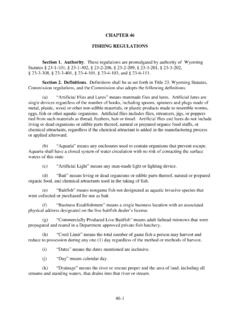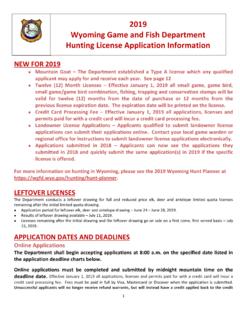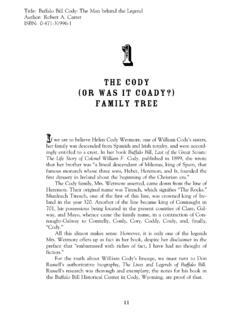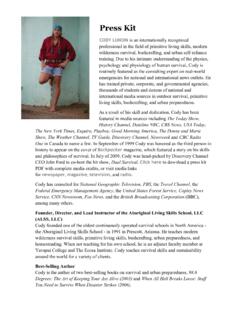Transcription of CODY REGION - Wyoming
1 The Wyoming game and fish department CODY REGION newsletter October 2017 Local, state, and federal partners work to operate Willwood Dam and protect the Shoshone River fishery Inside this month s issue: On the ground Pronghorn antelope classification Of interest Mystery solved! Access Yes provides local hunting opportunity 2017 bighorn sheep season going well Wood River moose The Shoshone River, downstream of Willwood Dam. An interagency group composed of the Wyoming Department of Environmental Qual-ity Water Quality Division (WDEQ-WQD), the Wyoming Game and Fish Depart-ment (WGFD), the Willwood Irrigation District, the United States Bureau of Reclama-tion, the Wyoming Water Development Office, the State Engineer s Office, and others have been working on developing a plan to allow for the operation of Willwood Dam while also protecting the downstream Shoshone River fishery.
2 This group is advising the public that they may notice slightly higher turbidity in the Shoshone River downstream of Willwood Dam between October 16 and October 31 as the water level behind the dam is lowered in preparation for winter. Lowering the wa-ter level is necessary to prevent the dam and other infrastructure from freezing, but will be done in a manner that will minimize impacts to the downstream fishery. This is part of a larger effort that has taken place since October/November 2016, when a large amount of sediment was released from behind Willwood Dam while mainte-nance work was being completed. In response to that event, WDEQ-WQD, WGFD, Willwood Irrigation District, and other partners formed three work groups tasked with 1) restoring aquatic life and habitat damaged by the sediment release; 2) evaluating alternatives for long-term management of the dam while also protecting downstream aquatic life; and 3) addressing sources of sediment upstream of Willwood Dam.
3 Work thus far includes the following: continued on page 2 WGFD Cody REGION newsletter October 2017 In the water Willwood dam 2 Trash Clean Up and Flushing Flow: On March 18 of this year, approximately 80 people from WGFD, WDEQ/WQD, Willwood Irrigation District, the Bureau of Reclamation, Cody-Powell Conservation Districts, Trout Unlimited, Cody High School Outdoor Club, Future Farmers of America, and the Greater Yellow-stone Coalition joined forces to pick up trash and debris that was released with the sediment in the Willwood area. Between April 3 and April 14 of this year, the Bureau of Reclamation assisted the effort through a request from the WGFD for a flushing flow of the Shoshone River by increasing the release of water from Buffalo Bill Dam from 2,000 cfs to 4,000 cfs.
4 The purpose of the flushing flow was to remove fine sediment that had been deposited during the 2016 release and improve habitat for fish. In addition to the flushing flow, the Shoshone River also received natural flows of 6,000 cfs for several weeks, which was five times higher than typical summer flows. Evaluations of the habitat downstream indicate the flushing flow in combination with the high spring and summer flows removed nearly all of the sediment from the Shoshone River channel that was deposited in the 2016 release. Evaluation of Fishery: The WGFD sampled the fish population downstream of Willwood Dam following the 2016 sediment release. A majority of the fish sampled in 2016 were brown trout less than 15 inches and rainbow and cut-throat trout less than 12 inches. The rainbow and cutthroat trout had been stocked prior to the sediment release. There were an estimated 442 trout per mile and 310 pounds of trout per mile in the Shoshone River following the 2016 re-lease.
5 This was down slightly from the estimated 478 trout per mile and 385 pounds of trout per mile estimated in 2013. Though it is difficult to quantify the direct loss of trout due to the release of sediment from Willwood Dam in 2016, the data suggest the sediment release led to a small reduction in the trout population and biomass. Game and Fish plans to continue monitoring the fishery to determine how the fishery is responding to management changes at Willwood Dam. Measuring Sediment Load and Water Quality: To better understand the amount of sediment that passes through and potentially needs to be passed through Willwood Dam, WDEQ/WQD has contracted with the United States Geologi-cal Survey to conduct real-time monitoring of suspended sediment in the Shoshone River upstream and downstream of Willwood Dam. Turbidity, and eventually suspended sediment data, will be available at when the equipment is installed. WDEQ/WQD also continues to monitor water quality of the Shoshone River both upstream and downstream of Willwood Dam.
6 Addressing Upstream Sources of Sediment: Powell Clarks Fork Conservation District and WDEQ/WQD are leading an effort to identify potential sediment sources upstream of Willwood Dam and plan voluntary best management practices to address sources that can be mitigated. Representatives from state, federal, and local agencies are partici-pating as well as local landowners and farmers. This group hosted a field tour in June 2017 to help educate agency personnel and other stakeholders on watershed characteristics and sources of sediment, including natural/background sources. For more information, contact David Waterstreet, or 307-777-6709, at the Wyoming Department of Environmental Quality or Jason Burckhardt, or 307-527-7125 at the Wyoming Game and Fish Department. A crew works to clear debris from the banks of the Shoshone River downstream of Willwood Dam last March. WGFD Cody REGION newsletter October 2017 On the ground 3 Pronghorn antelope classifications Dusty Lasseter, bear wise community coordinator with Game and Fish, Joe Kondelis, president of Western Bear Foundation and Don Frame, vice president of Wyoming Outdoorsmen.
7 Fifteen-Mile Herd Carter Mountain Badger Basin Herd Copper Mountain Herd Pronghorn antelope herd units and hunt areas within the Cody REGION . Carter Mountain Herd Unit: Greybull Biologist Les-lie Schreiber reports total pronghorn classified in this herd unit was the highest in the past 10 years. The 2017 fawn ratio was similar to the 10-year average, but lower than the highs seen in the past three years. The 2017 buck ratio was slightly higher than the 10-year average. In past years, total number of pronghorn classified in Hunt Area 81 was similar to the number classified in Hunt Area 78, but Hunt Area 81 has increased consid-erably in recent years. Total pronghorn observed was 2299 and fawn:doe:buck ratio was 52:100:52. Fifteen-Mile Herd Unit and Copper Mountain Herd Unit : Worland Biologist Bart Kroger reports that 1647 pronghorn were classified in Fifteen-Mile Herd Unit with a fawn:doe:buck ratio of 49:100:48, and that 1067 pronghorn were classified in the Copper Mountain Herd Unit with a doe:fawn:buck ratio of 75:10:63.
8 The 2017 fawn ratios for both herd units were down, with the Copper Mountain herd showing a ten percent decline, and the 15-Mile herd showing a 31 percent decline compared to 2016. Given 2014-2016 were record high fawn ratios for these herds, the 2017 fawn ratios are still near or slightly above the 10-year average for both herds. The 2016/17 winter conditions likely reduced body condition and health of pregnant does, thus resulting in fewer fawns being born and surviving. Buck ratios for both herds in 2017 were the high-est on record for the past 10 years. Hunt Area 79 was recently added to the Copper Mountain Herd Unit and was reported separately. Total pronghorn classi-fied in this individual hunt area was 445, the highest in the past 10 years. The 2017 fawn ratio (66:100) was higher than last year, but near the 10-year average (65:100). The 2017 buck ratio (65:100) was lower than last year, but above the 10-year average (59:100).
9 This information will be combined with the Copper Mountain Herd Unit when reported in 2017 Big Game Job Completion Report. Badger Basin Herd Unit: Cody Biologist Tony Mong reports that total pronghorn classified in 2017 was 404, a slight de-crease compared to last year but similar to the previous five-year average of 422. Distribution of animals across the unit was different than previous years, with difficulties in locating pronghorn in portions of the unit. The 2017 fawn ratios were 30:100, which is below the 10-year average of 36:100. The 2017 buck ratios were the lowest ever seen in this herd unit at 34:100. Each year, Game and Fish personnel collect ratio data on prong-horn antelope populations through ground observations before hunting seasons begin. In a given area, biologists observe pronghorn and record the total number of animals and the age and sex class of each pronghorn. From the total number sampled, biologists evaluate the number of fawns per 100 does, the number of adult bucks per 100 does and the number of yearling bucks per 100 does.
10 This information allows biologists to see how the population is doing and is used (in combination with other data) to evaluate hunting seasons, access herd productivity and determine survival. WGFD Cody REGION newsletter October 2017 Access Yes provides local hunting opportunity Access Yes, the Wyoming Game and Fish Department s public access program, is a program that facilitates the partnership between landowners and Game and Fish to create public hunting and fishing access on private land. Cody REGION Access Coordinator Jordan Winter said that throughout the Basin, 86 Walk-In Areas representing over 51,000 acres and nine hunter management areas representing over 174,000 acres of access are open to hunters this fall. In addition, access to approximately 128,000 additional acres of public land is also accessible because of the hunter management areas. Access Yes is funded in part through donations received from sportsman s groups and individuals who donate when they purchase a hunting or fishing license.


















